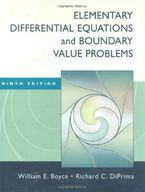Solution Found!
Solved: Consider an elastic string of length L whose ends are held fixed. The string is
Chapter 10, Problem 4(choose chapter or problem)
Consider an elastic string of length L whose ends are held fixed. The string is set in motion with no initial velocity from an initial position \(u(x, 0)=f(x)\). In each of Problem, carry out the following steps. Let L = 10 and a = 1 in parts (b) through (d).
(a) Find the displacement u(x,t) for the given initial position f(x).
(b) Plot u(x,t) versus x for \(0 \leq x \leq 10\) and for several values of t between t = 0 and t = 20.
(c) Plot u(x,t) versus t for \(0 \leq t \leq 20\) and for several values of x.
(d) Construct an animation of the solution in time for at least one period.
(e) Describe the motion of the string in a few sentence
\(f(x)=\left\{\begin{array}{ll}
1, & L / 2-1<x<L / 2+1 \quad(L>2) \\
0, & \text { otherwise }
\end{array}\right.\)
Questions & Answers
QUESTION:
Consider an elastic string of length L whose ends are held fixed. The string is set in motion with no initial velocity from an initial position \(u(x, 0)=f(x)\). In each of Problem, carry out the following steps. Let L = 10 and a = 1 in parts (b) through (d).
(a) Find the displacement u(x,t) for the given initial position f(x).
(b) Plot u(x,t) versus x for \(0 \leq x \leq 10\) and for several values of t between t = 0 and t = 20.
(c) Plot u(x,t) versus t for \(0 \leq t \leq 20\) and for several values of x.
(d) Construct an animation of the solution in time for at least one period.
(e) Describe the motion of the string in a few sentence
\(f(x)=\left\{\begin{array}{ll}
1, & L / 2-1<x<L / 2+1 \quad(L>2) \\
0, & \text { otherwise }
\end{array}\right.\)
Step 1 of 5
a)
Consider the wave equation.
\({a^2}{u_{xx}} = {u_{tt}}\) \( 0 < x < L , t > 0\) ;
The boundary conditions are \( u(0,t) = 0 , u(L,t) = 0 , t \ge 0\) ;
The initial conditions are \( u(x,0) = f(x) , u(x,0) = 0 , 0 \le x \le L\) ;
Where f is a given function describing the configuration of the string at \(t = 0\) .
The solution to this wave equation is
\(u(x,t) = \sum\limits_{n = 1}^\infty {{c_n}\sin \frac{{n\pi x}}{L}} \cos \frac{{n\pi at}}{L}\)
The initial condition \(u(x,0) = f(x)\) requires that
\(u(x,0) = \sum\limits_{n = 1}^\infty {{c_n}\sin \frac{{n\pi x}}{L}} = f(x)\)
\({c_n} = \frac{2}{L}\int\limits_0^L {f(x)\sin } \frac{{n\pi x}}{L}dx, n = 1,2,...\)
In this case, \(f(x) = \left\{ {\begin{array}{*{20}{c}}{1,}&{\frac{L}{2} - 1 < x < \frac{L}{2} + 1}&{(L > 2),}\\0&{otherwise}&{}\end{array}} \right.\)
Use the definition of f(x) in the equation of \({c_n}\).
\({c_n} = \frac{2}{L}\left( {\int\limits_0^{\frac{L}{2} - 1} {f(x)\sin } \frac{{n\pi x}}{L}dx + \int\limits_{\frac{L}{2} - 1}^{\frac{L}{2} + 1} {f(x)\sin } \frac{{n\pi x}}{L}dx + \int\limits_{\frac{L}{2} + 1}^L {f(x)\sin } \frac{{n\pi x}}{L}dx} \right)\)
\( = \frac{2}{L}\left( {0 + \int\limits_{\frac{L}{2} - 1}^{\frac{L}{2} + 1} {\sin } \frac{{n\pi x}}{L}dx + 0} \right)\)
\( = \frac{2}{L}\int\limits_{\frac{L}{2} - 1}^{\frac{L}{2} + 1} {\sin } \frac{{n\pi x}}{L}dx\)
Use the integral of sine \(\int {\sin Axdx = \frac{{ - \cos Ax}}{A}} \)
\({c_n} = \frac{2}{L}\left( {\frac{{ - \cos \frac{{n\pi x}}{L}}}{{\frac{{n\pi }}{L}}}} \right)_{\frac{L}{2} - 1}^{\frac{L}{2} + 1}\)
\(= \frac{2}{L}\left( {\frac{L}{{n\pi }}} \right)\left( { - \cos \frac{{n\pi x}}{L}} \right)_{\frac{L}{2} - 1}^{\frac{L}{2} + 1}\)
\( = \frac{2}{{n\pi }}\left( { - \cos \frac{{n\pi (\frac{L}{2} + 1)}}{L} - \left( { - \cos \frac{{n\pi (\frac{L}{2} - 1}}{L}} \right)} \right)\)
\(= \frac{2}{{n\pi }}\left( {\cos \left( {\frac{{n\pi }}{2} - \frac{{n\pi }}{L}} \right) - \cos \left( {\frac{{n\pi }}{2} + \frac{{n\pi }}{L}} \right)} \right)\)
Use the identity \(\cos \left( A \right) - \cos \left( B \right) = 2\sin \left( {\frac{{B - A}}{2}} \right)\sin \left( {\frac{{B + A}}{2}} \right)\) .
\({c_n} = \frac{2}{{n\pi }}\sin \left( {\frac{1}{2}\left( {\frac{{n\pi }}{2} + \frac{{n\pi }}{L} - \left( {\frac{{n\pi }}{2} - \frac{{n\pi }}{L}} \right)} \right)} \right)\sin \left( {\frac{1}{2}\left( {\frac{{n\pi }}{2} + \frac{{n\pi }}{L} + \left( {\frac{{n\pi }}{2} - \frac{{n\pi }}{L}} \right)} \right)} \right)\)
\(= \frac{2}{{n\pi }}\sin \left( {\frac{{n\pi }}{L}} \right)\sin \left( {\frac{{n\pi }}{2}} \right)\)
Substitute \({c_n}\) in the solution to the wave equation.
\(u(x,t) = \sum\limits_{n = 1}^\infty {\frac{2}{{n\pi }}\sin \frac{{n\pi }}{L}\sin \frac{{n\pi }}{2}\sin \frac{{n\pi x}}{L}} \cos \frac{{n\pi at}}{L}\)
